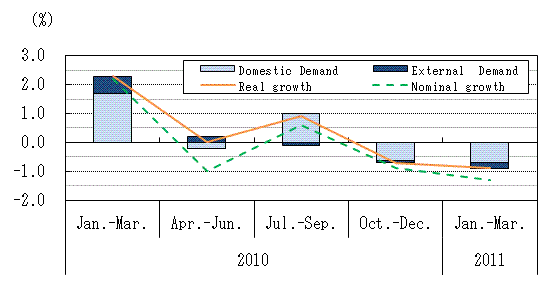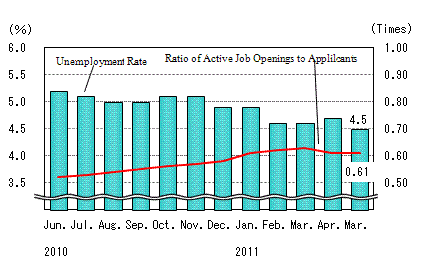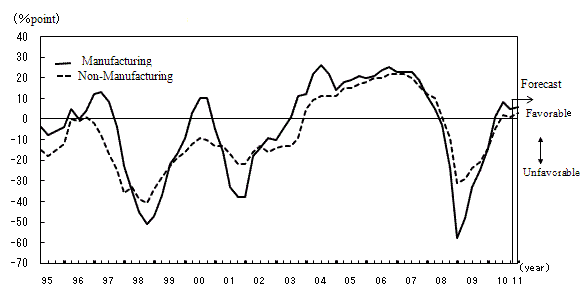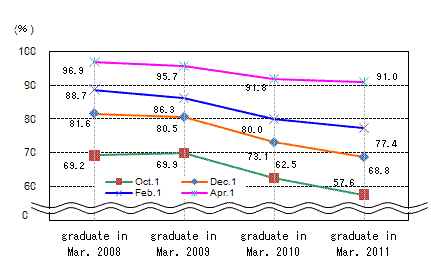Recent Statistical Survey Reports, June 2011
Statistical Survey Reports
2009 Economic Census for Business Frame (The main basic results, Final results)
Friday, June 3, released by the Ministry of Internal Affairs and Communications
In case of omitting establishments whose activities were unknown, the number of establishments in Japan was 6,043,000 as of July 1, 2009 and the number of persons engaged was 62,861,000.
It was in “wholesale and retail trade” that has most number of establishments and persons engaged.
In “accommodations, eating and drinking services”, the percentage of part-timers was high in “regular employees”.
The number of establishments including “individual proprietorship” and “other corporations” was 4.481 million. Among them, the number of “stock companies (including limited companies)” was 1.806 million.
Survey on Labor Economic Trend (May 2011)
Monday, June 6, released by the Ministry of Health, Labour and Welfare
By the judgment of employment surplus or shortage DI as of May 1, 2011, regarding the trend of the sense of employment surplus or shortage, in the total of industries surveyed, regular employees accounted for 0 (a decrease by 6 points from the previous term) . And, that of part-time workers accounted for 8 (a decrease by 1 point from the previous term) and the DI shows shortage for 7 consecutive terms.
The situation on employment due to the Great East Japan Earthquake
Wednesday, June 8, released by the Ministry of Health, Labour and Welfare
The number of active openings in three disaster prefectures (Iwate, Miyagi and Fukushima) on June 3 was 48,924. (Iwate: 11,228, Miyagi: 22,161, Fukushima: 15,535)
The number of active openings for disaster victims on June 3 was 41,668. (Iwate: 605, Miyagi: 2,145, Fukushima: 1,619)
The number of active applications of disaster victims on June 3 was 40,457. (Iwate: 7,698, Miyagi: 23,982, Fukushima: 8,777)
The number of employment consultation of three disaster prefectures was 390,186 (March 28-June 5).
The number of separation notices of three disaster prefectures from March 12 to June5 was 119,776, 2.3 times the previous year. (Iwate: 25,312 (1.9 times), Miyagi: 51,689 (2.2 times), Fukushima: 42,775 (2.7 times))
The number of claims allowed of three disaster prefectures from March 12 to June 5 was 76,719, 2.8 times the previous year. (Iwate: 16,293 (2.2 times), Miyagi: 35,667 (3.1 times), Fukushima: 24,759 (2.8 times))
National Accounts (The 2nd Preliminary Estimates Jan.-Mar. 2011)
Thursday, June 9, released by the Cabinet Office![]()
Real GDP (Gross Domestic Product) growth rate (Seasonally Adjusted) was -0.9% (-3.5% on annual basis), unchanged from the 1st preliminary estimates (annual basis, an increase of 0.2 points from the 1st preliminary estimates).
Of real GDP growth rate, -0.7% was contributed by domestic demand and -0.2% by external demand.
Quartely Estimates of GDP: Jan. ~Mar. 2011 (The 2nd Preliminary Estimates) Growth rate of GDP from the previous Quarters(seasonally adjusted)
Contributions of Domestic Demand and External Demand to Changes in GDP
Workmen's compensation of Brain and Heart Disease, mental disability and so on (FY2010)
Tuesday, June 14, released by the Ministry of Health, Labour and Welfare
Regarding the situation of workmen's compensation of brain and heart disease, the number of claim was 802, an increase of 35 from the previous fiscal year, and the number of grant decision was 285, a decrease of 8 from the previous fiscal year.
By industries, both of them were the most in “transport and postal activities”, followed by “wholesale and retail trade” and “manufacturing”. By jobs, the number of claim was the most in “transport and machine operation workers”, followed by “clerical workers” and “service workers”. The number of grant decision was the most in “transport and machine operation workers”, followed by “clerical workers” and “professional and engineering workers”.
As for mental disability, the former was 1,181, an increase of 45 from the previous fiscal year and the latter was 308, an increase of 74 from the previous fiscal year.
By industries, both of them were the most in “manufacturing”, followed by “wholesale and retail trade” and “medical, health care and welfare”. By jobs, the number of claim was the most in “clerical workers”, followed by “professional and engineering workers” and “service workers”. The number of grant decision was the most in “professional and engineering workers”, followed by “clerical workers” and “sales workers”.
Looking at suicide among mental disability, the number of claim was 171, an increase of 14 from the previous fiscal year, and the number of grant decision was 65, an increase of 2 from the previous fiscal year.
(*):The number of grant decision was the number of the cases resulting from employment and including the cases that claimed before FY 2010.
Monthly Labour Survey (Final Report in April)
Friday, June 17, released by the Ministry of Health, Labour and Welfare
Total amount of cash earnings (for business establishments with 5 or more employees) decreased by 1.4% from a year earlier, and contractual cash earnings decreased by 0.8% from a year earlier.
Scheduled cash earnings decreased by 0.7%, non-scheduled cash earnings decreased by 1.9%, and special cash earnings decreased by 19.7% from a year earlier. Real wage (total) decreased by 1.9% from a year earlier.
Non-scheduled hours worked by manufacturing industry workers at business establishments with 5 or more employees decreased by 6.7% from the previous month (seasonally adjusted).
Indexes of Business Conditions April 2011 (Revised Release)
Monday, June 20, released by the Cabinet Office
The Coincident Index of Composite Index (CI, revised figures, 2005=100) in April was 103.6, an increase of 0.2 points. And 3 months backward moving average decreased for 0.60 points, and 7 months backward moving average increased for 0.20 points. So the Assessment of Coincident Index was “"Improving", but the three-month backward moving average went negative due to the Great East Japan Earthquake.”
The Leading Index was 96.2, a decrease of 3.4 points, and the Lagging Index was 90.8, an increase of 1.9 points.
Survey on Labour Union Activities (2010)
Tuesday, June 28, released by the Ministry of Health, Labour and Welfare
The ratio of labour unions that experienced the corporate organization restructuring etc. the past three years was 37.9%. And the ratio of labour unions that has been involved in the execution of them was 85.8% (87.6% in the previous survey).
Indices of Industrial Production (May)
Wednesday, June 29, released by the Ministry of Economy, Trade and Industry![]()
The index of industrial production (seasonally adjusted) increased by 5.7% from the previous month.
According to the Survey of Production Forecast in Manufacturing, Production is expected to increase in June and July. The Synthetic judgment is “Industrial Production is on a recovery trend after the Great East Earthquake.”
Monthly Survey on Service Industries (Preliminary Report in April)
Wednesday, June 29, released by the Ministry
of Internal Affairs and Communications
(PDF:159KB) ![]()
The monthly sales amount of service industry in April 2011 was 21.8 trillion yen, a decrease of 7.3 % from the same month the year before. The total number of persons employed in the industry was 25.50 million, a decrease of 2.5% from the same month the year before.
2010 Population Census (Prompt sample tabulation)
Wednesday, June 29, released by the Ministry of Internal Affairs and Communications![]()
The 2010 Population Census shows that the total population of Japan as of October 1, 2010 is 128.056 million, which is an increase of 0.2 % compared with the population reported in the previous Population Census conducted in 2005. The proportion of the population aged 65 and over was 23.1% of the total population, a increase of 14.1% from the previous Population Census conducted in 2005.
The labour force participation rate (proportion of the population in labour force among the population 15 years of age and over, 110,024 thousand) was 60.7% (a decrease of 0.8point from the 2005 Population Census). That for men was 73.4% (a decrease of 1.9 point from the previous census), and that for women was 49.1% (an increase of 0.3point from the previous census).
Regarding the distribution of employed persons 15 years of age and over by industry, employed persons in “wholesale and retail trade” was 17.0%, “manufacturing” was 16.3%, “medical, health care and welfare” was 10.6% and so on.
Consumer Price Index (May)
Friday, July 1, released by the Ministry of Internal Affairs and Communications
The Consumer Price Index was 100.0, increased by 0.3% from the same month the year before. Omitting Fresh food, the comprehensive index was 99.9, an increase of 0.6% from the same month the year before.
And in the ward -areas of Tokyo in June (preliminary report), the former accounted for 98.9, a decrease of 0.2% from the same month the year before. The latter accounted for 98.8, an increase of 0.1% from the same month the year before.
Family Income and Expenditure Survey (May)
Friday, July 1, released by the Ministry of Internal Affairs and Communications
The average monthly income for a worker's household with 2 or more family members was decreased by 2.2% in real terms from the same month a year before.
With regard to the income contributing to increase - decrease rate, contribution of income earned by head of household accounted for -1.00 %, partner's income accounted for -1.52%, other household members' income accounted for -0.06% and so on.
The average monthly consumption expenditures for a worker's household with 2 or more family members was decreased by 1.0% in real terms from the same month a year before.
Labour Force Survey (May)(*)
Friday, July 1, released by the Ministry of Internal Affairs and Communications
The unemployment rate (seasonally adjusted) was 4.5%, decreased by 0.2 point from the previous month. That for men was 4.8%, decreased by 0.2 point from the previous month and that for women was 4.3%, increased by 0.1 point from the previous month.
The number of unemployed persons (seasonally adjusted) was 2.83 million, decreased by 90 thousand from the previous month.
The number of employees (seasonally adjusted) increased by 190 thousand from the previous month to 52.50 million.
(*):After March 2011, the result of the whole Japan except devastated quake-hit prefectures(Iwate, Miyagi and Fukushima) is published.
Report on Employment Service (May)
Friday, July 1, released by the Ministry of Health, Labour and Welfare
The ratio of active job openings to applicants (seasonally adjusted) was 0.61, unchanged from the previous month.
Trend in Unemployment Rate and Ratio of Active Job
Openings to Applicants (seasonally adjusted)
TANKAN (Short-Term Economic Survey of Enterprises) (June)
Friday, July 1, released by the Bank of Japan(PDF:199KB)![]()
The Diffusion Index (DI) (“Favorable”- “Unfavorable”) for business conditions in large enterprises of the manufacturing was -9 (6 in the previous quarter and forecast 2 in the coming quarter), and the non-manufacturing DI was -5 (3 in the previous quarter and forecast -2 in the coming quarter).
The Diffusion Index (DI) (“Excessive”- “Insufficient”) for employment conditions in large enterprises of all industries was 7 (4 in the previous quarter and forecast 4 in the coming quarter).
Business Sentiment (For Large Enterpries)
Survey on Situation of Preliminary Job Offers for New Graduate in Mar.2011 (University, etc.) (April 1, 2011)
Friday, July 1, released by the Ministry of Health, Labour and Welfare
The ratio of final-year university students who got an official job offer to applicants was 91.0%, decreased by 0.8 points from the same period a year earlier.
That of final-year junior college students (female only) was 84.1%, decreased by 4.3 points from the same period a year earlier.
That of final-year technology college students (male only) was 98.7%, decreased by 0.8 points from the same period a year earlier.
That of final-year vocational school students was 86.2%, decreased by 1.2 points from the same period a year earlier.
Trend in the percentage of final-year university students
with official job offer
Monthly Labour Survey (Preliminary Report in May)
Tuesday, July 5, released by the Ministry of Health, Labour and Welfare
Total amount of cash earnings (for business establishments with 5 or more employees) increased by 1.1% from a year earlier, and contractual cash earnings decreased by 0.6% from a year earlier.
Scheduled cash earnings decreased by 0.4%, non-scheduled cash earnings decreased by 3.3%, and special cash earnings increased by 67.7% from a year earlier. Real wage (total) increased by 0.7% from a year earlier.
Non-scheduled hours worked by manufacturing industry workers at business establishments with 5 or more employees increased by 0.4% from the previous month (seasonally adjusted).
Other Reports
Monthly Economic Report (June)
Monday, June 20, released by the Cabinet Office![]()
Upward movements are observed in the Japanese economy while difficulties continue to prevail, due to the Great East Japan Earthquake.(In the previous month, “The Japanese economy shows weakness recently, due to the influence of the Great East Japan Earthquake. Also, it remains in a difficult situation such as a high unemployment rate.”)
- Industrial production and exports show some upward movements after they declined due to the earthquake disaster.(In the previous month, “Industrial production and exports have declined recently due to the earthquake disaster.”)
- Corporate profits have decelerated and business investment has weakened, due to the earthquake disaster. (In the previous month, “Corporate profits are weighed down and business investment has weakened recently, due to the earthquake disaster.”)
- Firms show cautious judgment on current business conditions. (The same as the previous month)
- The employment situation experiences a pause in improvement and remains severe.(In the previous month, “While the employment situation remains severe, movements of an incipient recovery can be seen. However, the influence of the earthquake disaster has caused some weakness.”)
- Although private consumption remains weak, it began leveling off.(In the previous month, “Private consumption is showing weakness recently, due to the influence of the earthquake disaster. “)
- Recent price developments show that the Japanese economy is in a mild deflationary phase. (The same as the previous month)
Monthly Economic Labour Report (June)
Tuesday, June 21, released by the Ministry of Health, Labour and Welfare
The employment situation experiences a pause in improvement and remains severe.(In the previous month, “While the employment situation remains severe, movements of an incipient recovery can be seen. However, the influence of the earthquake disaster has caused some weakness.”)
| To view PDF files, you will need Adobe Acrobat Reader Software installed on your computer.The Adobe Acrobat Reader can be downloaded from this banner. |





